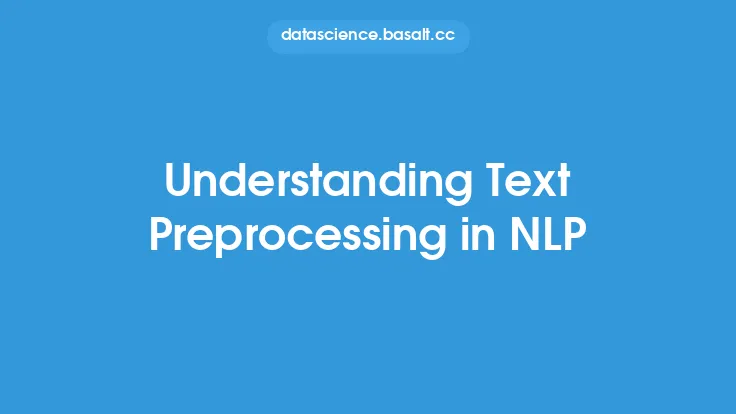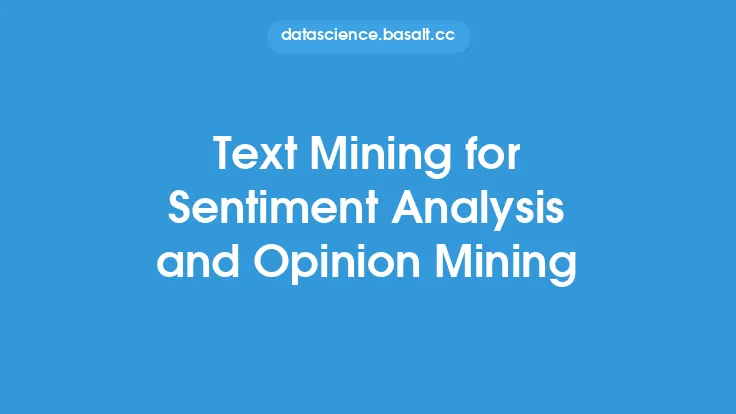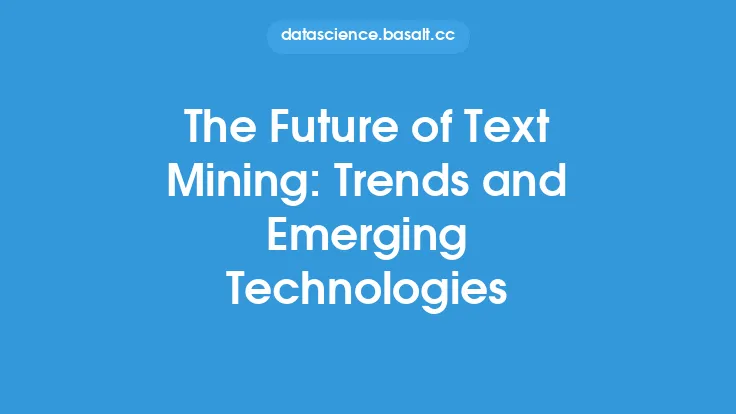Natural Language Processing (NLP) is a subfield of machine learning that deals with the interaction between computers and humans in natural language. It is a crucial aspect of artificial intelligence, as it enables computers to understand, interpret, and generate human language. One of the most significant applications of NLP is text classification and clustering, which involves categorizing text into predefined categories or grouping similar texts together. In this article, we will delve into the world of NLP for text classification and clustering, exploring the techniques, algorithms, and applications that make it possible.
Introduction to Text Classification
Text classification is a type of NLP task that involves assigning a label or category to a piece of text based on its content. This can be a binary classification problem, where the text is classified as either positive or negative, or a multi-class classification problem, where the text can belong to one of several categories. Text classification has numerous applications, including spam detection, sentiment analysis, and topic modeling. The goal of text classification is to develop a model that can accurately predict the label or category of a given text, based on its linguistic features and patterns.
Techniques for Text Classification
There are several techniques used for text classification, including:
- Rule-based approach: This approach involves using predefined rules to classify text. For example, a rule-based system might classify a text as spam if it contains certain keywords or phrases.
- Machine learning approach: This approach involves training a machine learning model on a labeled dataset, where the model learns to recognize patterns and relationships between the text features and the corresponding labels.
- Deep learning approach: This approach involves using deep learning models, such as convolutional neural networks (CNNs) or recurrent neural networks (RNNs), to classify text. Deep learning models can learn complex patterns and relationships in the text data, making them particularly effective for text classification tasks.
Text Clustering
Text clustering is a type of unsupervised learning task that involves grouping similar texts together based on their content. Unlike text classification, where the goal is to assign a label or category to a text, the goal of text clustering is to identify patterns and structures in the text data. Text clustering has numerous applications, including document organization, information retrieval, and topic modeling. The most common algorithms used for text clustering include:
- K-means clustering: This algorithm involves partitioning the text data into k clusters, based on the similarity between the texts.
- Hierarchical clustering: This algorithm involves building a hierarchy of clusters, where each cluster is a subset of the previous one.
- DBSCAN clustering: This algorithm involves grouping texts into clusters based on their density and proximity to each other.
Feature Extraction for Text Classification and Clustering
Feature extraction is a crucial step in both text classification and clustering, as it involves converting the text data into a numerical representation that can be processed by machine learning algorithms. The most common feature extraction techniques used for text classification and clustering include:
- Bag-of-words: This technique involves representing each text as a bag, or a set, of its word frequencies.
- Term frequency-inverse document frequency (TF-IDF): This technique involves representing each text as a vector of TF-IDF scores, which take into account the importance of each word in the text.
- Word embeddings: This technique involves representing each word as a vector in a high-dimensional space, where semantically similar words are closer together.
Evaluation Metrics for Text Classification and Clustering
Evaluating the performance of text classification and clustering models is crucial to ensure that they are accurate and effective. The most common evaluation metrics used for text classification include:
- Accuracy: This metric measures the proportion of correctly classified texts.
- Precision: This metric measures the proportion of true positives among all positive predictions.
- Recall: This metric measures the proportion of true positives among all actual positive instances.
- F1-score: This metric measures the harmonic mean of precision and recall.
For text clustering, the most common evaluation metrics include:
- Silhouette score: This metric measures the separation between clusters and the cohesion within clusters.
- Calinski-Harabasz index: This metric measures the ratio of between-cluster variance to within-cluster variance.
- Davies-Bouldin index: This metric measures the similarity between clusters based on their centroid distances and scatter within clusters.
Applications of Text Classification and Clustering
Text classification and clustering have numerous applications in various fields, including:
- Sentiment analysis: Text classification can be used to analyze customer reviews and feedback, determining whether they are positive, negative, or neutral.
- Spam detection: Text classification can be used to detect spam emails or messages, based on their content and keywords.
- Topic modeling: Text clustering can be used to identify topics or themes in a large corpus of text data, such as news articles or social media posts.
- Information retrieval: Text clustering can be used to organize and retrieve documents based on their content, making it easier to find relevant information.
Challenges and Future Directions
While text classification and clustering have made significant progress in recent years, there are still several challenges and future directions to explore. Some of the challenges include:
- Handling imbalanced datasets: Many text classification datasets are imbalanced, with one class having a significantly larger number of instances than the others.
- Dealing with noise and outliers: Text data can be noisy and contain outliers, which can affect the performance of text classification and clustering models.
- Improving interpretability: Many machine learning models, including those used for text classification and clustering, can be difficult to interpret and understand.
Future directions for text classification and clustering include:
- Using transfer learning and pre-trained models: Transfer learning and pre-trained models, such as BERT and RoBERTa, have shown significant promise in improving the performance of text classification and clustering models.
- Exploring multimodal and multilingual text analysis: With the increasing availability of multimodal and multilingual text data, there is a growing need to develop models that can handle these types of data.
- Developing more efficient and scalable algorithms: As the size of text datasets continues to grow, there is a need to develop more efficient and scalable algorithms that can handle large-scale text classification and clustering tasks.





